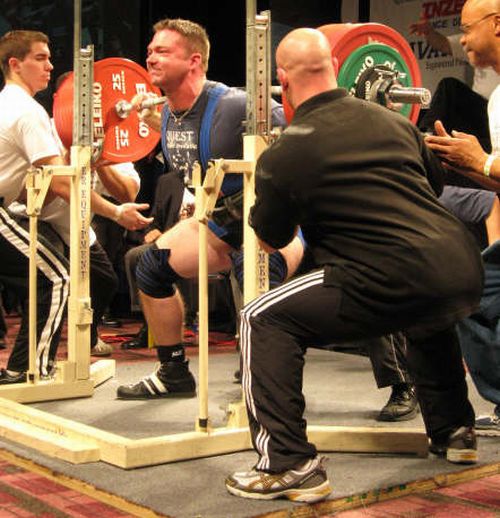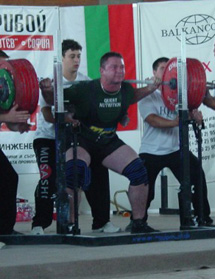Cracking Knees
by Mike Tuchscherer

No it's not the name of some Indian brave, it's a real problem that effects many strength athletes. I've spent the last year battling with swollen knees and the good old popping and crackling that usually signals the end of squatting as a hobby. But I've made progress in this battle and while it's not over, I think I may win. I'm writing this article since the internet doesn't seem to have all the information in one place and I want others to know that you don't have to give up the sport you love.
"Nick Underwood is not a licensed physician; take his advice at your own risk"
Ok with that out of the way..... First I'll give some basic information. When you squat there are four large muscle groups that take on the majority of the load, the quads, hammies, hips, and the lower back. While all these muscles need to be flexible and balanced in almost all cases of crackling knees (crepitus), in squatters and runners who have had no other knee injuries and have little pain in their knees it is due to a muscle imbalance in their quads.
The quad is made up of four muscles, the vastus medialis (teardrop), the vastus lateralis (the outside sweep), the final two are the vastus intermedius and rectus femoris they make up the center of the quad. Mike once claimed that his quads were so big that he in fact had pentas instead of quads, if you are like him this extra muscle is called vastus ur retardus (Just kidding Mike). All of these muscles anchor to the knee and hip in one fashion or another. The job of these muscles is to straighten the leg.
What I eventually learned
One of the largest reasons that some powerlifters develop crepitus is their perfect powerlifting squat stance and not so perfect genes. We have all been taught from the beginning to take a wide stance, point our toes out, force our knees out, and sit back into the lift. This technique makes maximum use of the large and powerful hip muscles and the powerlifter puts up nice numbers. But in this stance the lateralis is put in a shorter position and it is limited on how much emphasize is placed on it since its contraction during the lift portion of the squat is much shorter than the intermedius, femoris or medialis. Overtime the lateralis will become much weaker than the other muscles of the quad. Now in a lot of individuals the body will actually recognize this and compensate by increasing growth in the lateralis, but I wasn't that lucky. So if you're like me you lateralis stayed weak and all the other muscles started growing and pulling on it. The lateralis eventually got tired of getting pushed around by all the bigger muscles so it did the only thing it could, tightened up and the bigger the other muscles got, the tighter it got. This caused the lateralis to pull on both the lower part of my spine where it ties in and to pull on my knee cap. This resulted in my knee becoming agitated and rough causing the grating sound as the cartilage wore down. It also caused lower back pain since the spine was constantly being pulled out of position.

How I got here
The first thing I noticed was tightness in my lower back right around L4 and L5. This should have been a big wakeup call that something was wrong, but it wasn't too bad so I kept on lifting. Then I started having pain in my I.T. bands (long ligaments that run down the outside of your legs). But only at night so I was still able to squat during the day so I kept lifting and collegiate was coming up so I couldn't deal with it right then. Then occasionally my knees would swell up, but ice fixed that and there was no real pain so I let it go and got ready for nationals. At nationals I bombed out because one hip was higher than the other on all my squats. But I figured the judges hated me so I got ready to do a qualifier for Men's nationals. This is where I finally noticed that something was wrong. After the meet with ice bags on my swollen knees, I was reviewing my videos and saw that both my knees looked good from the side but when viewed from the front they were traveling to the outside of my feet. Frustrated, I went to the doctors who prescribed stretching and lots of it. So I stretched a lot and lifted light, the pain was gone in my back but the knees were getting worst. Then I did the worst thing I could have done, I quit squatting all together and started running to prepare for a triathlon. I literally spent nights awake with the phone in my hand ready to call 911. My hips and knees would lock in the middle of the night and put me in terrible pain. Occasionally I would take a step and pain would shoot through my knee that would take my breath away. After a few weeks of this I started doing some mobility exercises and the pain lessened but did not disappear.
During this whole madness I was doing research and trying to figure out the problem. Some time during this process my roommate talked me into doing a leg workout with him. He is a traditional bodybuilder style lifter so we did the leg press and hack squat along with a regular squat (I only did partials). The next day the pain was gone. I continued these workouts and the pain and crackling was disappearing. Then I got dumb and started squatting heavy to depth. While my hips and knees never locked again but my knees started getting swollen on a daily basis.
The Solution
At the end of all my trial and error I finally discovered that the lateralis was behind all my problems. I had been so focused on nationals that I did notice the warning signs and further more my training was way too specific. I was squatting with the same stance and not varying enough other exercises to help bring up lateralis and I paid for it.
The lateralis must be trained even though it does not play a huge part in your completion squat. There are two ways to do this. You can turn your toes straight or slightly inward in the squat or leg press. If you are already developing a deficiency you will find it hard to maintain a good arch and keep your toes tracking over your feet while you squat down. Don't push it too hard and go light. You don't have to get depth, remember this about training the deficiency not hitting a legal squat. In practice I've found squatting like this very difficult to do since my lateralis is extremely tight and weak. I have almost no power and can do only a few inches of travel. The other way is to use the hack squat. I know the hack squat is traditionally thought of as a good way to destroy your knees and I can understand why since it puts them in a bad leverage point. However, the hack squat targets the lateralis better than any other exercise I've tried and I've tried them all. I put my toes straight and go as deep as I can. I don't go heavy on this exercise because I don't want to force the stretch and I have almost no strength on this machine.
Three weeks of this and I feel like a new man. My legs are more flexible, I have little knee pain and it gets better every day. My knees still travel out a little in a powerlifting stance squat but they are getting better. I'm gonna give it a couple months before putting squats of this type back into my program, but I'm feeling optimistic. The crackling is lessening too, not gone but cartilage takes a long time to heal and the muscles aren't balanced yet.
I'm not sure if my solution will help anyone but me, but if you've noticed those knees traveling out a bit and heard a bit of crackling, you may want to jump on that hack squat machine once a week or so. Don't think a little light hacking would hurt ya.
Mike Tuchscherer is the owner of Reactive Training Systems, a company dedicated to individualized physical training. The goal of RTS is to help you become a dominant force in your sport! Learn more by visiting www.ReactiveTrainingSystems.com.
Mike himself is an accomplished Powerlifter. He has over 12 years of experience training and researching the best training methods in the world. Mike has competed in raw and single ply competitions. He recently won the Gold medal representing the USA at the 2009 World Games; becoming the first American male to ever win this distinction. His best lifts in IPF competition are a 903 squat, a 644 bench press, an 826 deadlift, and a 2342 total in the 275 pound weight class.
More Articles By Mike Tuchscherer
Return to the Workout Articles Archive
|